Bosch Dishwasher E17: How It Ruins Your Washes Completely
So, you just started your dishwasher, but instead of the typical gentle swoosh of water, you’re greeted with an odd buzzing sound and an E17 error code.
What’s happening? Don’t worry – there’s no electrical meltdown going on in there!
What does E17 mean on Bosch dishwasher, then?
Bosch Dishwasher E17 Error Code means a problem with water flow. It can be due to an inconsistent water supply, broken float switch, broken water level sensor, or debris in the float chamber and filters. Cleaning and replacing these parts will fix the error.
Don’t worry though – no need for a technician yet! I’ll tell you about this error and how to clear it quickly. Try the fixes I give ASAP to avoid eating on dirty dishes!
When Bosch Dishwasher E17 Error Occurs
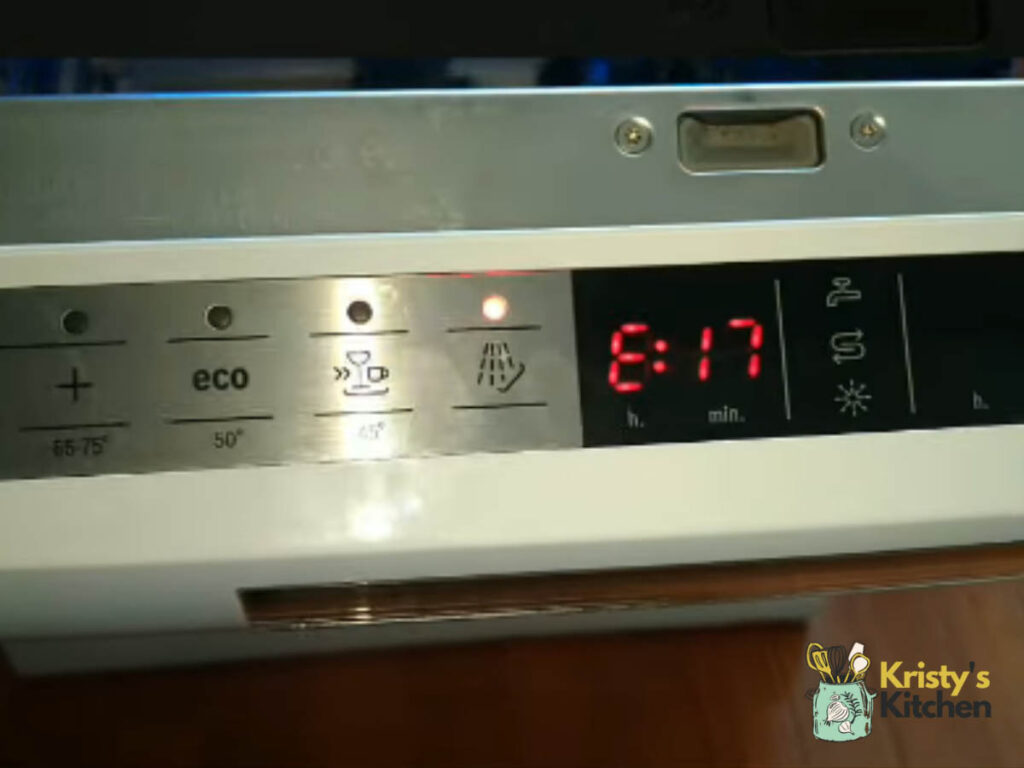
So, this E17 error is the opposite of E16. Rather than popping up because of overfilling, it appears the dishwasher fails to get filled with water at all.
It can ruin your wash quality, as you need water for the machine to actually clean.
Here are the main reasons why your water flow isn’t working right:
1. Water Supply Issues
The error can be attributed to:
- Water Supply Valve Fault: The inlet valve may be faulty or clogged, hindering water flow.
- Low Water Pressure: Insufficient main supply pressure leads to inadequate water filling.
- Kinked or Damaged Water Line: A bent or damaged water line obstructs water flow, triggering the E17 error.
2. Faulty Float Switch
The float, responsible for detecting water levels, can get stuck in the bottom or be in the wrong position, causing the dishwasher to think it’s already full and prevent water from entering.
3. Clogged Filters
Clogged filters can prevent water from entering the dishwasher in different ways:
- Blocked Inlet Filter: The filter that screens out debris in the water might be clogged, preventing water from entering.
- Clogged Spray Arms: If the dishwasher’s spray arms are clogged, water won’t distribute evenly, leading to a shortage of water inside.
4. Defective Water Level Sensor
A malfunctioning water level sensor can cause False Water Level Indication, leading the dishwasher to stop filling water prematurely due to inaccurate feedback to the control board.
5. Dirty Bottom And Float Chamber
When these areas are dirty, they can block water flow or misinterpret water levels, resulting in the dishwasher not filling with water correctly and triggering the E17 error.
How To Fix E17 Error In Bosch Dishwasher
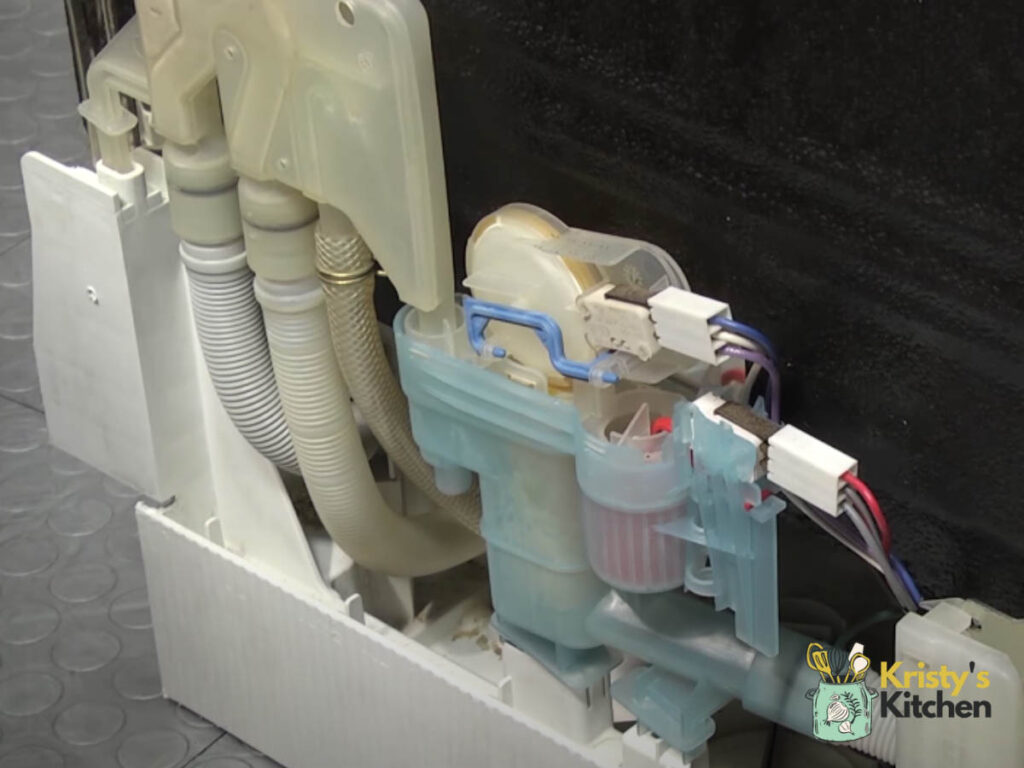
Alright, let’s fix that E17 error on your Bosch dishwasher together! Follow these simple step-by-step fixes, and get it sorted in no time.
Fix 1: Check The Water Supply System
Let’s start with a simple fix, checking if your water supply is actually working.
It’s a common culprit for this error, so let’s see if we can get things flowing smoothly again.
- Turn off the dishwasher and unplug it.
- Locate the water supply valve, usually under the sink or behind the dishwasher.
- Make sure the water supply valve is fully open.
- Check the water supply hose for any kinks, bends, or damage.
- Ensure the main water supply to your house provides sufficient water pressure.
Fix 2: Clean Filters
You can also give the filters a simple clean in case they have something that’s blocking the water flow, do so by the following steps:
- Open the dishwasher door and slide out the lower dish rack.
- Find the inlet filter at the bottom of the dishwasher and clean it by rinsing it under running water.
- Inspect the spray arms for any clogs and remove any obstructions.
- If your dishwasher has a separate drain filter, check and clean it as well.
Fix 3: Clean the Bottom and Float Chamber
That didn’t work? Well then, you’ll need to clean the dishwasher’s bottom and the float chamber.
Sometimes, a little debris can cause big issues, but with a bit of cleaning, you can get that dishwasher back to its sparkling performance.
Here’s how you can do so:
- Turn off the dishwasher and empty it.
- Remove the bottom rack to access the bottom area.
- Thoroughly clean the bottom of the dishwasher to remove dirt and debris.
- Locate the float chamber (a small, usually round or dome-shaped part) at the center of the bottom area.
- Check the plastic or styrofoam float inside the float chamber for free movement.
- Clean the float chamber if any debris is present.
- Put the bottom rack back in place.
Fix 4: Take Care of The Float Switch
This fix is the most complicated, besides replacing the water inlet valve.
Start by checking if the float switch needs a replacement.
To inspect the float switch and fix it, follow these steps:
- Turn off the dishwasher’s power and disconnect the water supply and electricity.
- Locate the float switch near the float chamber beneath the dishwasher’s tub.
- Check for visible damage or cracks on the float switch.
- Gently lift the float in the float chamber and ensure it moves smoothly without resistance. Listen for a clicking sound.
- Test the float switch with a multimeter on continuity setting. There should be continuity when the float is raised and none when lowered.
- If the float switch shows continuity as described, it’s likely not the cause of the E17 error. If not, proceed to replace the float switch.
- Disconnect wires from the old float switch.
- Remove the old float switch using pliers and the new float switch, securing it with screws or clips.
- Reconnect the wires to the new float switch in the original positions.
- Reassemble the removed parts.
- Turn on the dishwasher’s power and water supply.
- Test the dishwasher by running a short cycle to ensure the new float switch works.
Following these steps, you can easily check and replace the float switch, resolving the E17 error and ensuring proper dishwasher functionality.
Fix 5: Inspect And Potentially Replace The Water Inlet Valve
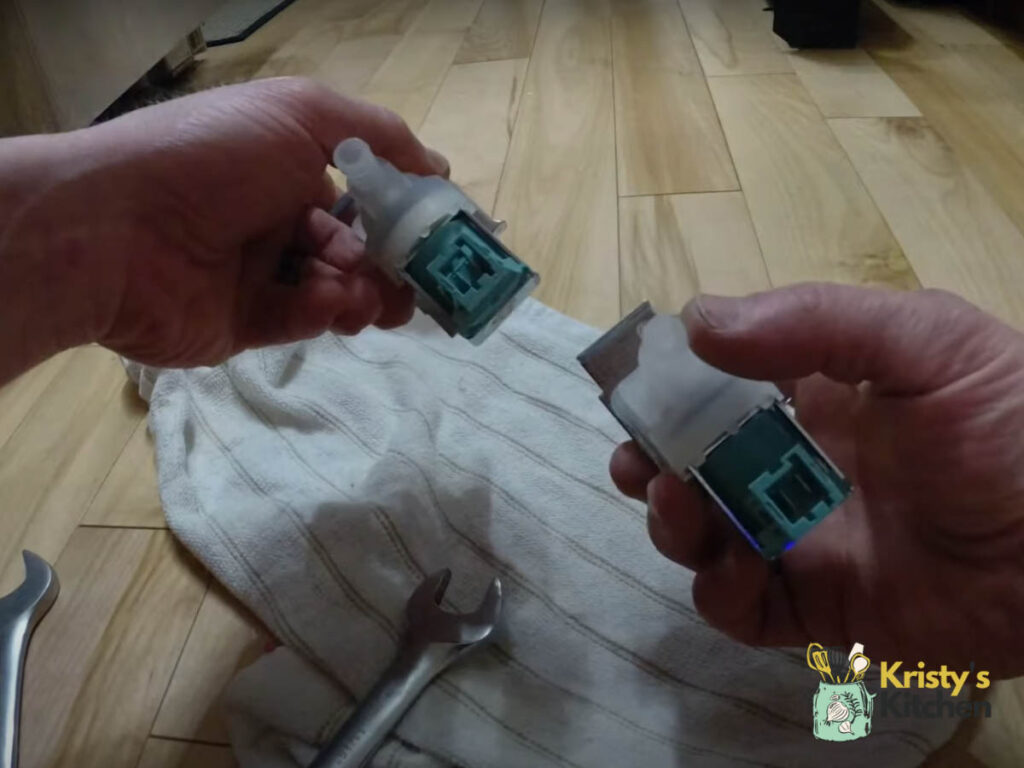
Like the float switch, you’ll need to check this one first, so start with that, then move on to fixing:
- Turn off the dishwasher power and disconnect the water and power supply.
- Locate the water inlet valve at the bottom of the dishwasher.
- Check for leaks or visible damage.
- Briefly turn on the water supply with the dishwasher off and the hose disconnected.
- If there is continuous water flow or no flow, the valve may be faulty.
- Test the valve’s electrical connections with a multimeter for continuity.
- If the valve shows no leaks or damage and stops water flow when disconnected, it’s likely not causing the E17 error.
- If there are water flow or electrical problems, move on to replacing the valve.
- To replace the valve, remove the old one hidden behind a cover at the bottom.
- Carefully disconnect the water supply hose using pliers, remove screws or clips holding the old valve, and detach wires connected to the old valve.
- Install the new valve in the same spot, securing it with screws or clips.
- Attach wires to the new valve in their original positions.
- Reconnect the water supply hose and tighten it with pliers.
- Turn on the water supply and check for leaks.
- Replace the removed covers or parts.
- Turn on the dishwasher power and water supply.
- Run a full cycle to ensure the E17 error is resolved.
Fix 6: Check And Replace The Water Level Sensor
Here’s what you need to do:
- Turn off the dishwasher and unplug it.
- Remove the front or access panel to access the water level sensor.
- Locate the water level sensor near the float assembly under the dishwasher tub.
- Check the sensor’s wiring and connectors for damage or looseness.
- Test the sensor’s continuity using a multimeter set to “ohms” or “resistance” mode.
- If the sensor shows continuity and no visible damage, it’s likely functioning correctly and doesn’t need replacement.
- If there’s no continuity or visible damage, consider replacing the water level sensor.
- To replace the sensor, disconnect the wires from the old one.
- Remove the old water level sensor from its mounting location.
- Install the new water level sensor in the same position.
- Reconnect the wires securely to the new sensor.
- Reassemble the panels removed earlier.
- Plug the dishwasher back in.
- Run a test cycle to ensure the E17 error is resolved and the new water level sensor functions correctly.
The Risks of Bosch Dishwasher E17 Fault
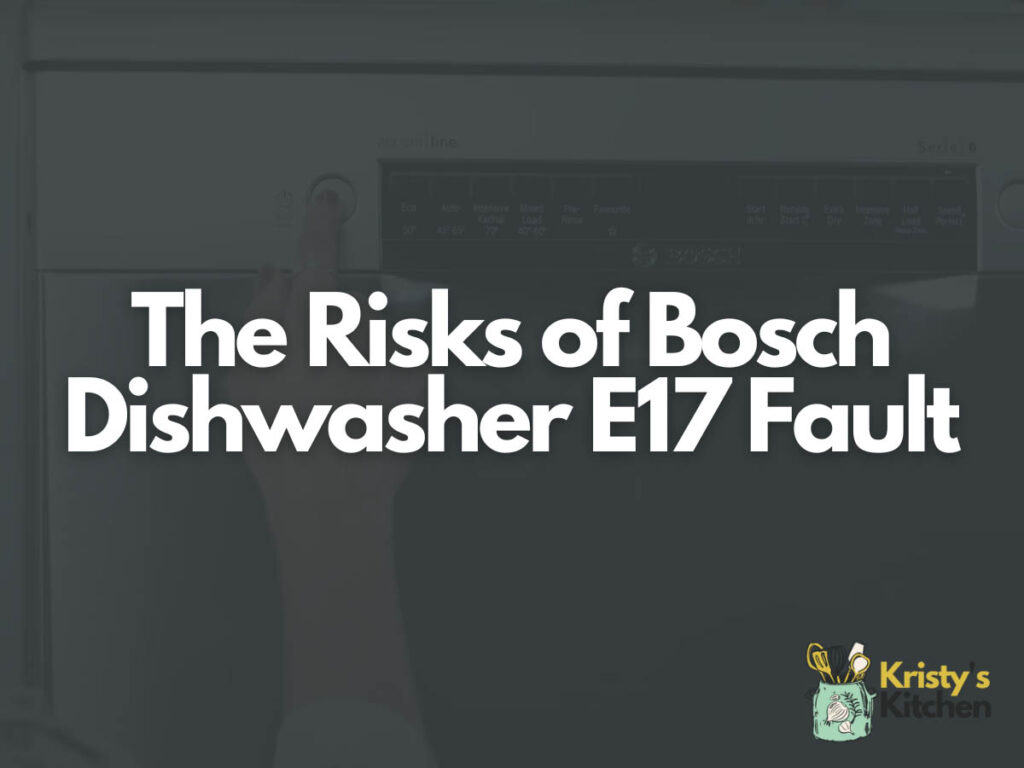
The E17 fault is one of the more hassle-filled errors. It means you’ll need to do a lot more maintenance than other Bosch dishwasher error codes.
Some of the annoying problems and potential risks this error code include:
- Messy Dishes: E17 error leads means less water for the washer to work with, so it leaves poorly cleaned dishes with stains and food residue.
- Water Troubles: The E17 fault can cause water leaks, potentially damaging kitchen floors and cabinets.
- Costly Repairs For Other Parts: Ignoring the E17 error can stress other dishwasher parts, leading to expensive repairs in the future.
Prevent E17 on Bosch Dishwashers With These Tips
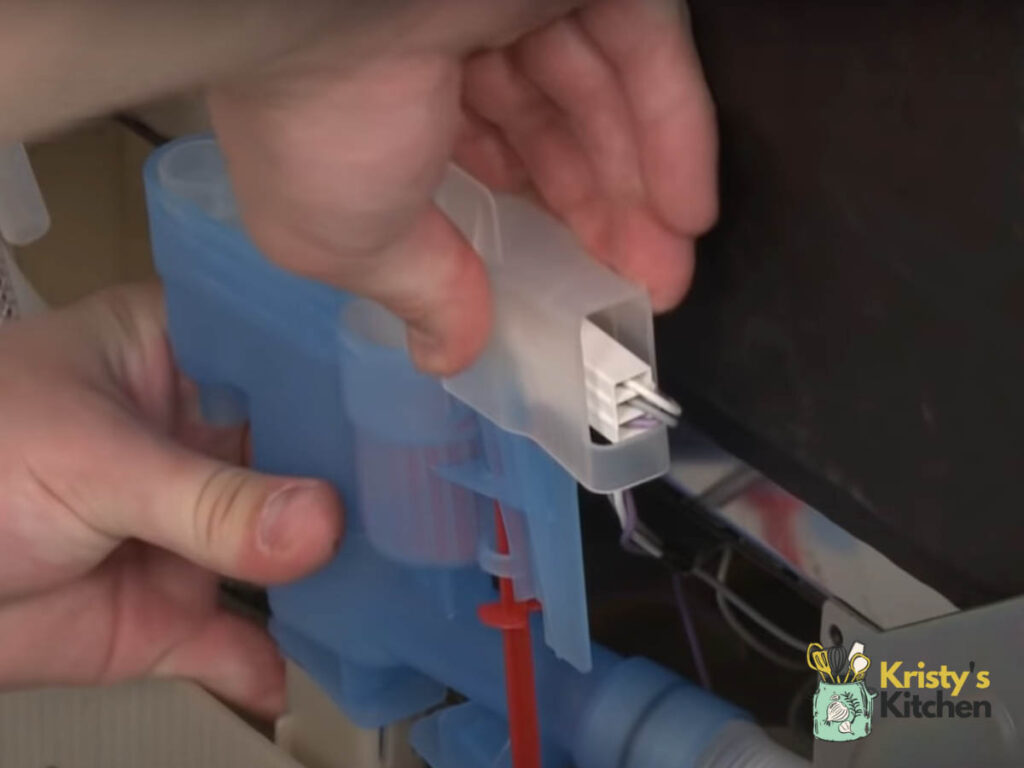
Nobody likes dealing with a faulty dishwasher, especially when it’s the E17 error causing the trouble.
To save you from the hassle and potential risks, here are some specific and straightforward prevention tips:
- Check Water Supply Regularly: Ensure the water supply valve and hose are in top-notch condition, free from twists or damage that could hinder water flow.
- Keep Filters Clean: Regularly clean the inlet filter and spray arms to prevent any nasty clogs and maintain a smooth water flow.
- Take Care of the Float Assembly: Keep an eye on the float assembly to make sure it moves freely up and down, allowing it to detect water levels accurately.
- Test Water Inlet Valve and Sensor: Periodically use a multimeter to test the water inlet valve and water level sensor, catching any issues before they become bigger problems.
- Load the Dishwasher Wisely: Avoid overstuffing the dishwasher, allowing it to distribute water evenly and do its job properly.
- Use Recommended Detergents: Stick to the right dishwasher detergent to avoid creating excessive suds and potential water flow troubles
FAQs
A clogged drain filter, a faulty drain pump, or a blocked drain hose are common reasons why a Bosch dishwasher might not drain properly. Based on whether you get the Bosch Dishwasher E24 error or the Bosch Dishwasher E25 error, there are different fixes for this.
Yes, using detergents or additives that are not approved for your dishwasher can create too many suds, causing the E17 error due to water supply problems.
Yes, if your Bosch dishwasher is still under warranty, the E17 error code should be covered. Contact Bosch for assistance if you can’t do the job yourself.
Yes, you can try to reset your bosch dishwasher by turning it off and unplugging it for a few minutes. Plug it back in and see if the error clears. If the issue persists, further troubleshooting might be needed.
To prevent this error, it’s a good idea to inspect the water inlet valve once a year. Replace it if you notice any signs of damage or if it’s not working correctly.
Final Thoughts
By following these simple tips and fixes, you’ll keep your Bosch dishwasher swishing along happily as it does its job, rather than trying to clean your dishes with thin air – the E17 fault will be a thing of the past.
So, what’re you holding out for? Go try them out so you can enjoy a smooth dishwashing experience without any unnecessary headaches!
